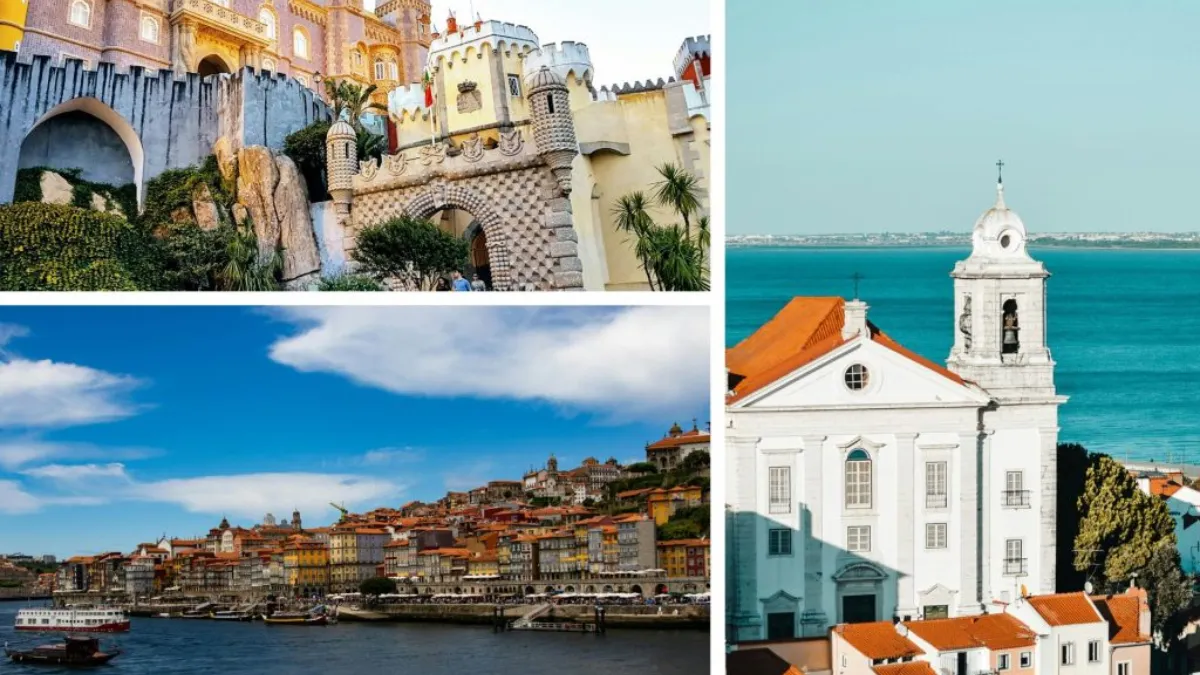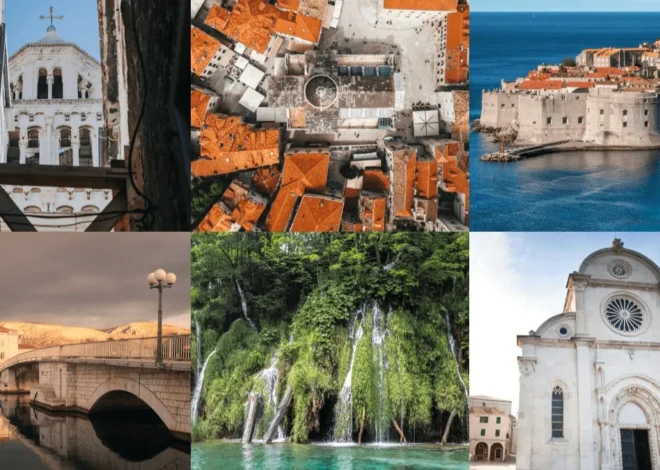
Top 25+ Best Places to Visit in Portugal for Culture and Adventure
In the heart of Southern Europe lies Portugal, a country that captures travelers with its vibrant culture, exquisite cuisine, and breathtaking scenery. Every corner of this charming nation feels like a discovery waiting to happen. If you’re dreaming of uncovering the best places to visit in Portugal, from ancient cities to sun-soaked coasts, let’s explore them together with Flextopics!
The Douro Valley
Tucked away in northern Portugal, the Douro Valley is a masterpiece of nature and human craftsmanship. Stretching through the cities of Peso da Régua, Pinhão, and Porto, this UNESCO World Heritage Site is a journey through terraced vineyards cascading down sunlit hillsides.
As you cruise along the meandering Douro River, the view shifts from ancient stone villages to lush orchards and green slopes. It’s also the birthplace of the world-famous Port wine often called the “king of wines.” For over two millennia, the Douro region has produced some of the finest vintages known to humankind.

The Historic City of Guimarães
Often referred to as the cradle of Portugal, Guimarães is a city where history breathes through every cobblestone. It was here that King Afonso I founded Portugal in 1143, and the iconic inscription “Aqui Nasceu Portugal” (“Portugal was born here”) proudly marks the city’s ancient walls. Wandering through its labyrinth of narrow medieval streets feels like stepping back in time.
Perched on a hilltop, Guimarães Castle stands tall built in the 10th century and guarded by a bronze statue of the nation’s first king. From this vantage point, you can spot the Palace of the Dukes of Braganza, now a museum and sometimes an official residence for the President of Portugal. Not far away, the Church of Nossa Senhora da Oliveira showcases a stunning mix of Gothic and later architectural styles, a testament to centuries of Portuguese artistry and devotion.
The Enchanting Madeira Islands
Floating serenely in the Atlantic Ocean, Madeira is often called “the Island of Eternal Spring” and for good reason. With mild temperatures ranging from 16°C in winter to 22°C in summer, the weather feels pleasantly springlike all year round. This volcanic archipelago is a paradise of rugged cliffs, natural lava pools, cascading waterfalls, and sweeping ocean views.
The best way to explore Madeira is by boat, gliding toward Funchal the island’s lively capital. There, you’ll find historic churches, bustling markets, and friendly locals selling freshly caught seafood and tropical fruits. Madeira’s calm yet captivating charm makes it a haven for those seeking peace, beauty, and a touch of adventure.
Peneda-Gerês National Park
Hidden among Portugal’s northern mountains, Peneda-Gerês National Park is a sanctuary of wild landscapes and ancient history. Towering peaks, lush forests, and crystal-clear waterfalls paint a scene of untamed beauty. Beyond its natural splendor, the park is a geological treasure trove, home to granite formations dating back nearly 300 million years.
The famed Mêda da Rocalva rock outcrop draws countless hikers and photographers each year. As you wander its trails, you may encounter prehistoric remains stone tombs and dolmens built by early settlers thousands of years before Christ. Few places in Europe blend geological wonder and cultural heritage as gracefully as Peneda-Gerês.
Nazaré Fishing Village
Just a short drive from Lisbon lies Nazaré, a colorful seaside town where tradition and thrill intertwine. Once a humble fishing village, Nazaré is now famous worldwide for its colossal waves — some reaching over 30 meters attracting surfers from every corner of the globe. Yet beyond the adrenaline, Nazaré remains deeply authentic. The air carries the scent of the sea, and the golden beaches stretch endlessly beneath the Atlantic sun.
Wander its charming streets to discover the Church of Nossa Senhora da Nazaré and the Fishermen’s Museum, both preserving the town’s maritime soul. As evening falls, enjoy freshly grilled seafood in a beachfront café while watching local boats return with the day’s catch a moment that perfectly captures the simple joy of Portuguese life.
Setúbal
Just 50 kilometers south of Lisbon, Setúbal is where the locals escape for sun, sea, and flavor. With its golden beaches and the famous crispy fried cuttlefish Choco Frito, this coastal city feels like Lisbon’s beloved backyard. Strolling through the city, you can’t miss the Setúbal Castle, perched high above with panoramic views of the coastline and terracotta rooftops below.
Then, unwind at Galapos Beach, where gentle waves and sunshine create the perfect retreat. Don’t forget to explore the old Fortress of St. Philip, built in 1676 once a mighty defense structure, now a window into Portugal’s maritime past.
Obidos Town
Few places in Portugal feel as magical as Óbidos. This medieval village was once a royal gift literally. King Afonso reclaimed it from the Moors and presented it to his queen, turning Óbidos into the private treasure of Portugal’s royal consorts. Walking through its narrow cobblestone streets feels like stepping into a storybook.
Whitewashed houses adorned with vibrant flowers line the winding paths, leading to the grand Óbidos Castle and the historic Church of Santa Maria. Time seems to slow here it’s easy to lose yourself in the charm of this centuries-old village surrounded by stone walls and stories of love and legacy.
Serra da Estrela National Park
In central Portugal, adventure lovers find paradise at Serra da Estrela National Park. Known as the “Roof of Portugal,” this mountain range offers dramatic peaks, crystal-clear lakes, and an incredible diversity of flora and fauna. One of its most mysterious wonders is the Covão dos Conchos, a seemingly bottomless whirlpool hidden within a lake.
When photos of it went viral in 2016, it instantly became one of the country’s most intriguing natural attractions. Whether you’re hiking, skiing in winter, or simply breathing in the crisp mountain air, Serra da Estrela feels like a place where the earth itself whispers serenity.
Coimbra City
Perched on a hill overlooking the Mondego River, Coimbra is Portugal’s fourth-largest city and home to one of Europe’s oldest universities. But beyond its academic fame, Coimbra radiates an old-world charm that feels both peaceful and inspiring. Exploring the Old Cathedral (Sé Velha) and the beautiful Santa Cruz Monastery, you can sense centuries of history in every stone. And when evening falls, take a stroll down Rua Ferreira Borges, where cafés and shops invite you to slow down, sip a coffee, and simply watch life unfold.
Azores Island
Far out in the Atlantic Ocean lies the Azores, a mesmerizing archipelago of nine volcanic islands. Each island has its own personality from lush green hills and hidden caves to crystal-blue lagoons and dramatic cliffs. Though remote, the Azores have become a dream destination for adventurers.
Here, you can dive into underwater worlds, explore lava tunnels, or hike along rugged coastal trails. One of the most unforgettable experiences is a boat trip to watch dolphins and whales in their natural habitat a truly magical encounter that reminds every traveler why Portugal is one of Europe’s most captivating destinations.
Old Town of Sintra
Tucked away amid the lush Serra de Sintra mountains, Sintra feels like a page torn from a fairytale. Recognized as a UNESCO World Heritage Site, this ancient city enchants visitors with its royal palaces, romantic gardens, and cobblestone streets framed by colorful villas. The air here is fresh and misty, carrying the scent of pine and the distant sea. A short drive will take you to Cabo da Roca, the westernmost point of mainland Europe, where the Atlantic waves crash dramatically against rugged cliffs a scene that stays in your memory long after you leave.
Alfama District
In the heart of Lisbon, the Alfama District tells stories of Portugal’s past with every narrow alleyway and pastel-colored home. This is Lisbon’s oldest neighborhood a place where laundry flutters from balconies, Fado music echoes at dusk, and life moves at a gentle pace. Unlike the grand squares and ornate palaces elsewhere, Alfama charms with its humble authenticity. Wandering through its maze of steep lanes feels like stepping back in time, discovering the poetic soul of the city one turn at a time.
Torre de Belém Tower
Standing proudly along the banks of the Tagus River, the Belém Tower is perhaps Lisbon’s most iconic monument a lasting symbol of Portugal’s Age of Discovery. Built in the early 16th century by architect Francisco de Arruda, this fortress once guarded the city’s harbor. Its elegant Manueline design, carved entirely from pale limestone, makes it look almost ethereal in the sunlight. From the balcony on the second floor, you can gaze across the shimmering Tagus and watch sailboats drift by a peaceful reminder of Lisbon’s maritime legacy.
Aqueduto das Águas Livres
For a mix of history and incredible architecture, head to the Aqueduto das Águas Livres, one of Lisbon’s engineering marvels. Stretching over 58 kilometers, this grand aqueduct crosses the Alcântara Valley with sweeping stone arches that seem to defy time. Built in the 18th century, it once supplied water to the entire city. Today, visitors come not only to admire its stunning design but also to enjoy panoramic views of Lisbon from above a perfect spot for unforgettable photos.
Tram 28
No trip to Lisbon is complete without hopping on the legendary Tram 28. Painted in bright yellow and creaking along its historic tracks, this charming tram winds through some of Lisbon’s most famous districts from the hills of Graça to the heart of Alfama. As it rattles past colorful facades, ancient cathedrals, and cozy cafes, you’ll feel the city’s pulse in every turn. It’s more than just transportation it’s a moving postcard, capturing the essence of Lisbon in motion.
Douro River
If there’s one river that defines Portugal’s heritage, it’s the Douro River. Though not the longest, it carries centuries of history tied to the famous Port wine industry. In Portuguese, “Douro” means “gold,” a fitting name for a river that sparkles beneath the sun and nourishes the vineyards lining its banks. Today, scenic river cruises have become a must-do experience, taking visitors through rolling hills of grapevines, traditional wine estates, and the iconic Port wine cellars near the enchanting city of Porto.
Ribeira District
One of the most beloved areas for European travelers, the Ribeira District perfectly captures Porto’s authentic spirit. Resting gracefully along the Douro River, this medieval neighborhood is a colorful maze of narrow alleys, charming cafés, and historic houses. Recognized by UNESCO as a World Heritage Site, Ribeira invites you to slow down, wander through its cobblestone streets, and savor life like a local. Be sure to enjoy a glass of Port wine or a plate of grilled codfish at one of the cozy riverside restaurants it’s a memory you’ll treasure.
Torre dos Clérigos
Standing tall at 76 meters, the Torre dos Clérigos is one of Portugal’s most iconic landmarks. Built in the 18th century, this Baroque masterpiece amazes visitors with its intricate stonework and graceful silhouette. Climbing the 225 steps to the top may be a challenge, but the reward is well worth it a panoramic view of Porto’s terracotta rooftops and the glistening Douro River stretching into the horizon.
São Bento Railway Station
Often called one of the most beautiful train stations in the world, São Bento in Porto is far more than a transportation hub it’s a living museum. Designed by architect José Max Da Silva, the station’s façade radiates elegance, but it’s the interior that steals the show. The grand hall is adorned with over 20,000 Azulejo tiles, each piece forming a vast mural that tells the story of Portugal’s history and culture. It took more than eleven years to complete this magnificent work, making São Bento a true national treasure.
Dom Luís I Bridge
The Dom Luís I Bridge is not just an engineering feat it’s a defining symbol of Porto itself. Spanning the Douro River with two distinct levels, the upper deck carries the metro while the lower serves vehicles and pedestrians. Designed with a striking iron framework, this double-decked bridge offers one of the best sunset views in the city. Whether you’re crossing on foot or capturing photos from the riverside, the bridge provides an unforgettable glimpse of Porto’s soul.
Bom Jesus do Monte Sanctuary
One of Portugal’s most sacred and visually striking landmarks, Bom Jesus do Monte offers both a spiritual and architectural journey. Pilgrims climb the grand Baroque staircase stretching 116 meters high, flanked by ornate fountains and statues that narrate stories from the Bible. The ascent is divided into three symbolic sections the Passion of Christ, the Five Senses, and the Three Virtues: Faith, Hope, and Charity.
At the summit stands a majestic Neoclassical church with twin bell towers and a dramatic depiction of Christ’s crucifixion. Behind the church, visitors can explore octagonal chapels, tranquil fountains, and serene gardens a perfect retreat for reflection and awe.
Palácio do Raio
Located in Braga, the dazzling Palácio do Raio is a stunning example of 18th-century Portuguese Baroque architecture. Once a noble family’s residence, the palace’s brilliant blue-and-gold façade and intricately detailed windows make it one of the city’s most photogenic spots. Today, it serves as a museum, inviting travelers to step inside and experience the grandeur of its lavish interiors while uncovering stories from Braga’s aristocratic past.
Praça da República Square
To experience the pulse of city life in Porto, spend time at Praça da República, one of the city’s liveliest squares. Bustling from morning till night, the square is surrounded by historic buildings and local cafés where both locals and tourists gather. At its center stands a 10-meter bronze statue of King Peter IV on horseback a symbol of pride and history. From here, you’re just a short stroll away from São Bento Station and the iconic Torre dos Clérigos, making it an ideal starting point for your urban adventure.
Arco da Porta Nova
As you wander through the charming pedestrian street Rua do D. Diogo de Sousa, you’ll come across the Arco da Porta Nova, an 18th-century Baroque gateway that once marked the entrance to Braga’s old city. Passing under its stone archway feels like stepping back in time beyond it lies a delightful maze of cobblestone streets filled with cafés, shops, and local life. It’s the perfect place to pause for a cup of tea and soak up the city’s laid-back atmosphere.
Café Vianna
No trip to Braga would be complete without a visit to Café Vianna, a historic establishment that’s been part of the city’s identity since 1858. Once a favorite gathering spot for aristocrats, politicians, and artists, this elegant café has witnessed centuries of conversation and culture. Today, visitors can sip coffee under its vintage arches and imagine the spirited debates that once shaped the nation an experience that’s both nostalgic and quintessentially Portuguese.
The Roman Temple of Évora
Hidden in the heart of the Iberian Peninsula, the Roman Temple of Évora stands as one of the best-preserved Roman ruins in all of Europe. Built more than two millennia ago to honor Emperor Augustus, this ancient monument has survived wars, natural decay, and centuries of change.
Though its roof has long collapsed, the rectangular foundation and 14 original Corinthian columns still rise proudly above the granite base, offering a powerful glimpse into Portugal’s Roman past. The temple’s timeless charm also makes it a favorite spot for photographers and couples looking for a fairytale wedding backdrop.
Évora Cathedral (Sé de Évora)
Constructed in 1186, this Roman Catholic cathedral is one of the most striking examples of medieval architecture in Portugal. Its pink granite façade, flanked by two towering spires, commands attention from afar. As you step through the grand entrance, twelve intricate statues of the apostles greet you a masterpiece of craftsmanship and devotion. Inside, the vast marble columns and vaulted ceilings create an atmosphere both solemn and majestic, leaving visitors in awe of its enduring beauty.
The Chapel of Bones (Capela dos Ossos)
For travelers with a taste for the unusual, the Chapel of Bones offers an experience that’s both eerie and thought-provoking. Constructed using the bones of over 5,000 monks, this chapel was built by Franciscan friars as a reminder of life’s impermanence. The walls and pillars, carefully adorned with human skulls and bones set in cement, bear the haunting message inscribed above the entrance: “We bones that are here, for yours await.” Despite its grim appearance, the chapel invites quiet reflection on the cycle of life and the passage of time.
Almendres Cromlech (Cromeleque dos Almendres)
Just outside Évora lies one of Europe’s most fascinating prehistoric sites the Almendres Cromlech. Composed of nearly 100 oval-shaped stones arranged in concentric circles, this megalithic monument predates Stonehenge by about 2,000 years. Archaeologists believe the stones were aligned with the sun, moon, and stars, possibly serving as an ancient astronomical observatory. Others suggest it was a sacred site for rituals and ceremonies. Today, visitors can wander among the weathered stones, feeling the mystic energy of a civilization that once worshiped the cosmos.
Évora’s Wineries and Vineyards
A trip to Évora wouldn’t be complete without sampling its world-class wines. The rolling vineyards surrounding the city produce some of Portugal’s finest vintages, where traditional methods meet modern winemaking techniques. One of the most renowned estates, Fitapreta Vinhos, welcomes guests to explore its cellars, taste its aromatic blends, and stroll through rows of sun-drenched grapevines. From the first sip to the last, every glass tells a story of heritage, passion, and the timeless art of Portuguese winemaking.
From ancient Roman ruins to charming vineyards and coastal gems, Portugal offers endless wonders for every traveler. Each destination tells its own story, filled with history, flavor, and breathtaking beauty. If you’re planning your next adventure, don’t miss the chance to discover the best places to visit in Portugal and experience the true essence of Southern Europe with Flextopics as your travel companion.



